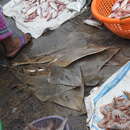Diagnostic Description
provided by Fishbase
This species is distinguished by the following set of characters: disc is wedge-shaped, rather large, its width 35-37% TL, its length 1.2-1.3 times width; snout is relatively short, length 2.5-2.7 times interspiracular distance, ~3.4 times interorbital width; orbit diameter 1.2-1.4 times the spiracle length; nostrils are moderately oblique, length 1.3-1.5 times internarial distance; mouth width 6.3-6.9% TL; preoral length 5.5-5.9 times internarial distance; posterior nasal flaps are broad; two spiracular folds, the outermost fold subequal to marginally taller than inner fold; ridges of the rostral cartilage almost parallel, widely separated, converging slightly anteriorly but not constricted medially; anterior cartilage weakly sickle-shaped, almost truncate posteriorly; distance between the fifth gill slits 2.5-2.7 times in ventral head length; prebranchial sensory pore system distinct, extending posteriorly to margin of first gill slit; postscapular sensory canal notched, the lateral pores exposed; with weak thorn patches on supraorbit and scapular region, and row of rudimentary thorns (inconspicuous) along dorsal midline; denticles on dorsal fins densest anteriorly, more sparse posteriorly; dorsal fins are small, height of first 7.7-8.1% TL; pelvic-fin inner margin subequal to or shorter than its base length; interdorsal distance 2.3-2.9 times first dorsal-fin base; dorsal caudal margin 1.9-2.0 times the preventral margin; upper jaw with ~118 tooth rows; snout angle ~61°; pectoral radials 68-72; post-synarcual centra ~164; nasal lamellae ~49. Colouration: dorsal fins brownish anteriorly while dusky posteriorly and apically; dorsal disc of adults is uniformly brown to greenish, with or without large, regularly spaced cloudy blotches (faint orange to dusky, more or less symmetrically arranged and of irregular sizes); ventral disc and tail are pale; undersurface of snout without large, black, teardrop marking (Ref. 123963).
- Recorder
- Estelita Emily Capuli
Life Cycle
provided by Fishbase
Exhibit ovoviparity (aplacental viviparity), with embryos feeding initially on yolk, then receiving additional nourishment from the mother by indirect absorption of uterine fluid enriched with mucus, fat or protein through specialised structures (Ref. 50449).
Migration
provided by Fishbase
Amphidromous. Refers to fishes that regularly migrate between freshwater and the sea (in both directions), but not for the purpose of breeding, as in anadromous and catadromous species. Sub-division of diadromous. Migrations should be cyclical and predictable and cover more than 100 km.Characteristic elements in amphidromy are: reproduction in fresh water, passage to sea by newly hatched larvae, a period of feeding and growing at sea usually a few months long, return to fresh water of well-grown juveniles, a further period of feeding and growing in fresh water, followed by reproduction there (Ref. 82692).
Biology
provided by Fishbase
Found on benthic inshore areas on continental shelf to at least 76 m depth (Ref. 123963). Also known to inhabit river mouths. Ovoviviparous (Ref. 50449). Confused with other species in the Indian Ocean, biology unknown (Ref. 114953).
Importance
provided by Fishbase
fisheries: minor commercial; price category: low; price reliability: questionable: based on ex-vessel price for species in this genus

